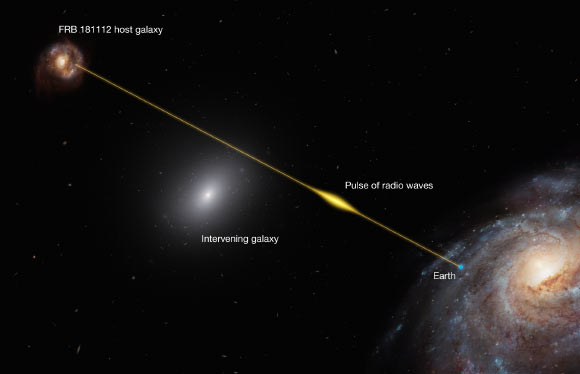Fast Radio Burst Exposes Halo of Massive Galaxy | Astronomy – Sci-News.com
In November 2018, CSIRO’s Australian Square Kilometre Array Pathfinder (ASKAP) detected a new fast radio burst, an enigmatic blast of cosmic radio waves lasting less than a millisecond. Follow-up observations with ESO’s Very Large Telescope and other telescopes identified not only the host galaxy of the event, named FRB 181112, but also a bright galaxy in front of it. Now astronomers have analyzed the signal from FRB 181112 to characterize the diffuse gas in the halo of the foreground galaxy.

An artist’s impression of FRB 181112 traveling through the halo of a massive galaxy 4 billion light-years from Earth. Image credit: M. Kornmesser / ESO.
A halo of a galaxy contains both dark and ordinary (baryonic) matter that is primarily in the form of a hot ionized gas.
While the luminous part of a massive galaxy might be around 30,000 light-years across, its roughly spherical halo is 10 times larger in diameter.
Halo gas fuels star formation as it falls towards the centre of the galaxy, while other processes, such as supernova explosions, can eject material out of the star-forming regions and into the galactic halo.
One reason astronomers want to study the halo gas is to better understand these ejection processes which can shut down star formation.
“The halo of gas can actually extend out 10 times further than the stars in a galaxy, and can contain a substantial amount of the matter that’s in a galaxy,” said Dr. Jean-Pierre Macquart, an astrophysicist at the Curtin University node of the International Centre for Radio Astronomy Research (ICRAR).
“But it’s very difficult to see the gas directly with a telescope.”
The signal of FRB 181112 was comprised of a few pulses, each lasting less than 40 microseconds.
The short duration of the pulses puts an upper limit on the density of the halo gas because passage through a denser medium would broaden the duration of the radio signal.
The astronomers calculated that the density of the halo gas must be less than 0.1 atoms/cm3.
“Like the shimmering air on a hot summer’s day, the tenuous atmosphere in this massive galaxy should warp the signal of the fast radio burst. Instead we received a pulse so pristine and sharp that there is no signature of this gas at all,” Dr. Macquart said.
The team found no evidence of cold turbulent clouds or small dense clumps of cool halo gas.
FRB 181112 also yielded information about the magnetic field in the halo, which is very weak — a billion times weaker than that of a refrigerator magnet.
“The signal from FRB 181112 exposed the nature of the magnetic field around the galaxy and the structure of the halo gas,” said University of California Santa Cruz’s Professor J. Xavier Prochaska.
“The study proves a new and transformative technique for exploring the nature of galaxy halos.”
At this point, with results from only one galactic halo, the researchers cannot say whether the low density and low magnetic field strength they measured are unusual or if previous studies of galactic halos have overestimated these properties.
“This galaxy may be special. We will need to use fast radio bursts to study tens or hundreds of galaxies over a range of masses and ages to assess the full population,” Professor Prochaska said.
The findings were published in the journal Science.
_____
J. Xavier Prochaska et al. The low density and magnetization of a massive galaxy halo exposed by a fast radio burst. Science, published online September 26, 2019; doi: 10.1126/science.aay0073






